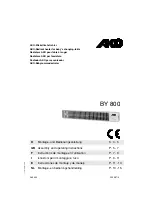
4 - 3
OPERATING PROCEDURES
Read all of this manual to become thoroughly familiar with this vehicle. Pay particular attention to all Notices, Cautions, Warnings, and Dangers.
4
4
4
4
BEFORE INITIAL USE
Read, understand and follow the safety label on the instrument panel. Be sure you understand how to operate the
vehicle, its equipment as well as how to use it safely. Maintaining good performance depends to a large extent on the
operator.
Improper use of this vehicle could result in severe injury or death. The series of vehicles are light
duty utility vehicles. They are NOT All Terrain Vehicles (ATV’s).
This vehicle is not a toy and using it while engaging in horseplay is dangerous.
Plan carefully before using the vehicle to go significant distances over questionable terrain.
Remember that a one hour drive may take many hours to walk out should you run out of battery
power or be stranded by becoming stuck on unsuitable terrain.
Hydrogen gas is generated as a natural part of the lead acid battery charging process. A 4%
concentration of hydrogen gas is explosive and could cause severe injury or death. Charging
must take place in an area that is adequately ventilated (minimum of 5 air exchanges per hour).
To reduce the chance of battery explosion that could result in severe injury or death, never
smoke around or charge batteries in an area that has open flame or electrical equipment that
could cause an electrical arc.
Hydrogen gas is generated in the charging cycle of batteries and is explosive in concentrations as low as 4%.
Because hydrogen gas is lighter than air, it will collect in the ceiling of buildings necessitating proper ventilation. Five
air exchanges per hour is considered the minimum requirement.
Never charge a vehicle in an area that is subject to flame or spark. Pay particular attention to natural gas or propane
gas water heaters and furnaces.
Before a new vehicle is put into operation, the items shown in the
INITIAL SERVICE CHART
must be performed.
The vehicle batteries must be fully charged before initial use.
Check for leaks that could have developed in shipment from the factory.
Check for correct tire inflation. See GENERAL SPECIFICATIONS.
Determine and record the braking distance required to stop the vehicle for future brake performance tests.
Remove the protective clear plastic from the seat bottom and back rest before placing the vehicle in service
ITEM
SERVICE OPERATION
Batteries Charge batteries
Seats
Remove protective plastic covering
Brakes
Check operation
Establish acceptable stopping distance
Tires
Check air pressure (see SPECIFICATIONS)
Portable Remove from vehicle and properly mount
Charger
INITIAL SERVICE CHART
Содержание Express L4 - Electric
Страница 1: ...622014 Owner s Guide ISSUED JULY 2011 REVISED JUNE 2012 ...
Страница 81: ......
















































